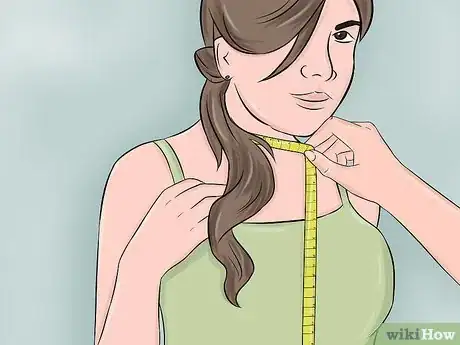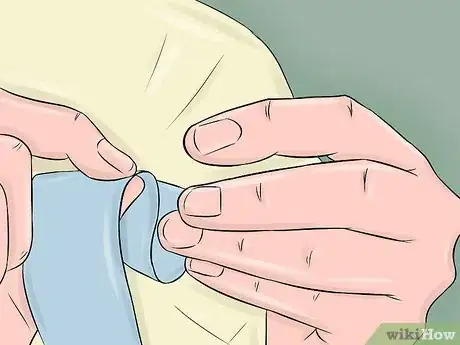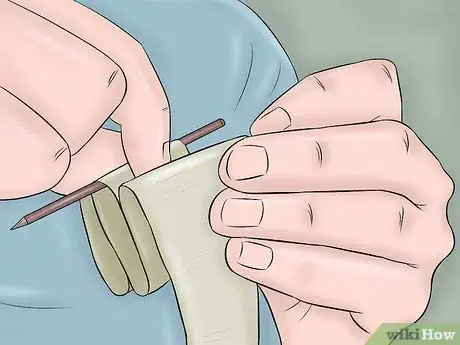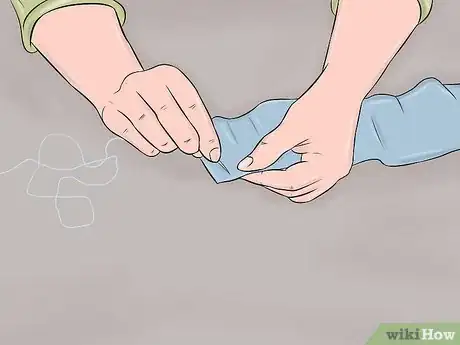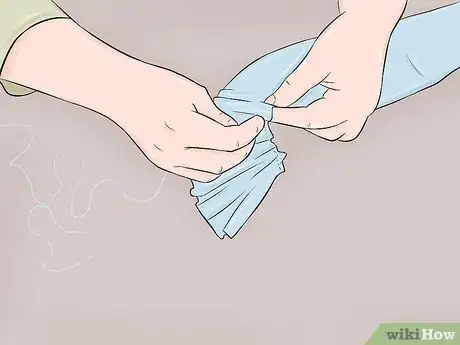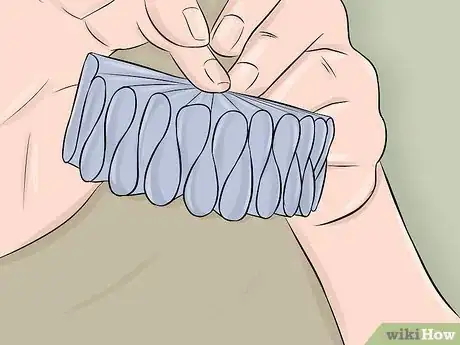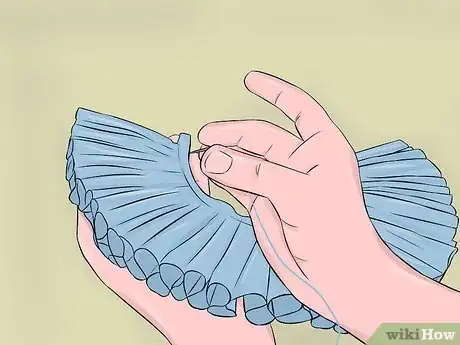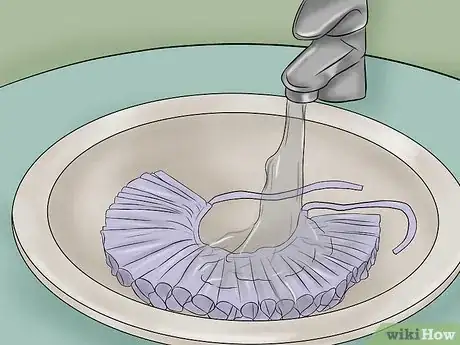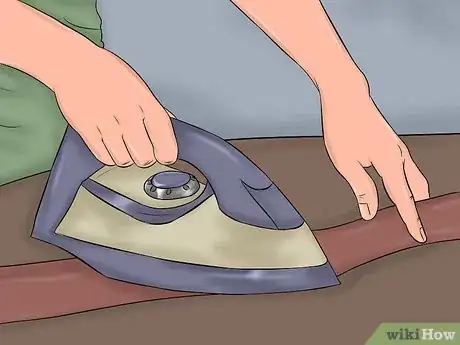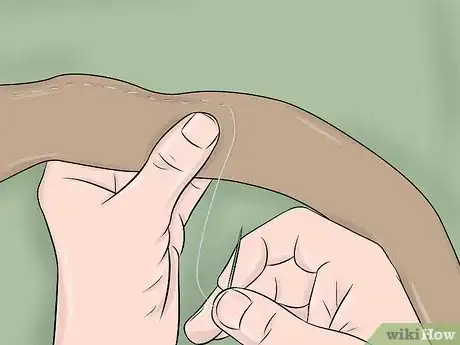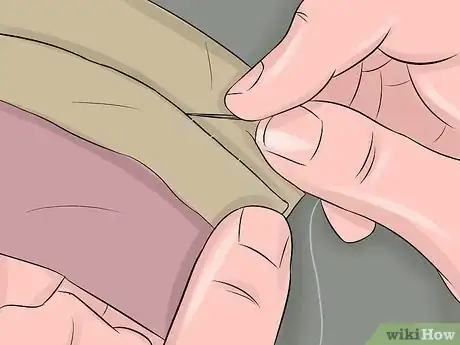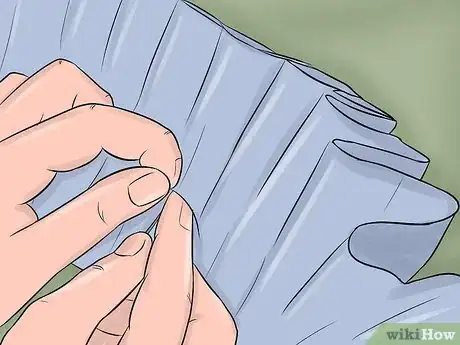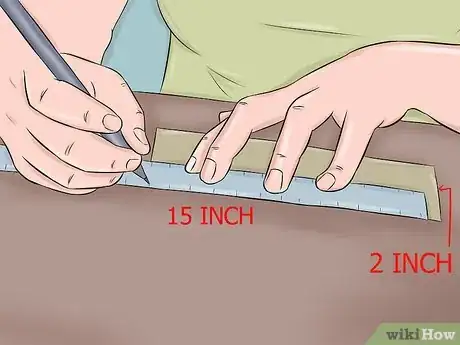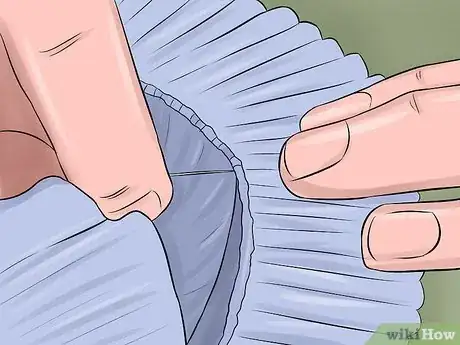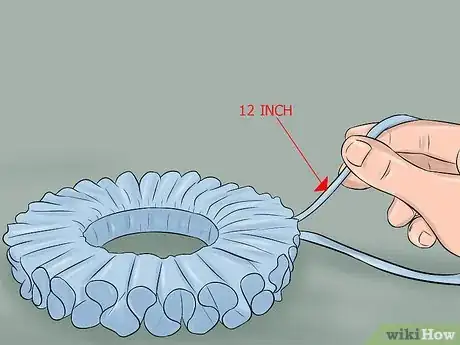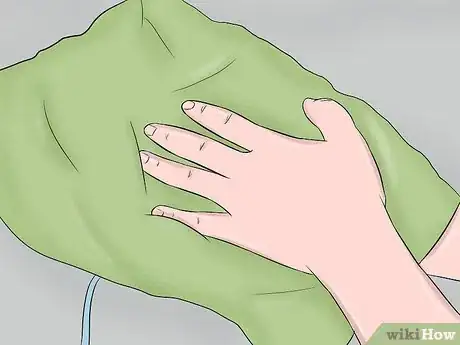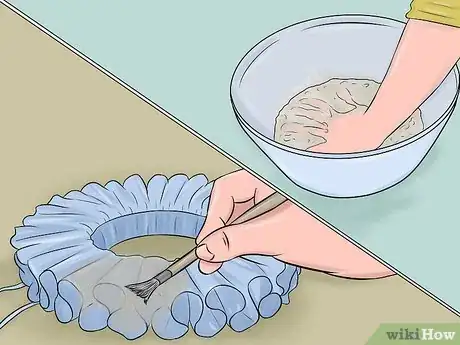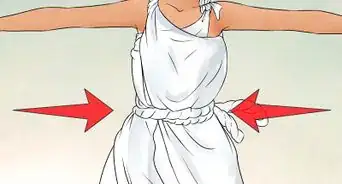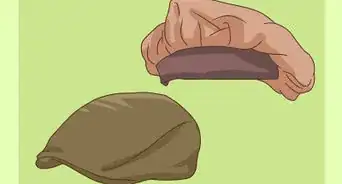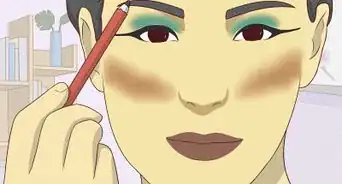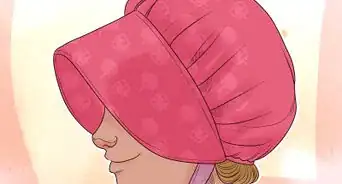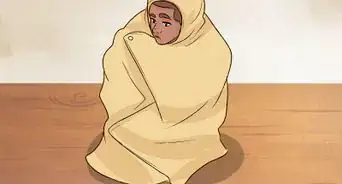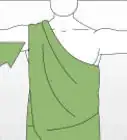wikiHow is a “wiki,” similar to Wikipedia, which means that many of our articles are co-written by multiple authors. To create this article, 20 people, some anonymous, worked to edit and improve it over time.
wikiHow marks an article as reader-approved once it receives enough positive feedback. In this case, 84% of readers who voted found the article helpful, earning it our reader-approved status.
This article has been viewed 163,481 times.
Learn more...
The ruff is one of the distinguishing features of the Elizabethan age. It was worn by the middle and upper class as a fashionable neck accessory, like a necktie. Ruffs came in a variety of widths, shapes, decorations, and even colors.[1] The process to make an Elizabethan ruff, with ribbon or with linen, is not complicated but it will require some time and patience.
Steps
Making a Ruff Out of Wired Ribbon
-
1Measure the wearer's neck. Take the measuring tape and drape it around the wearer's neck. Get a comfortable measurement, not too loose or too tight. Keep in mind the ruff is going to fit right over the wearer's shirt collar.
- Cut the 1” satin ribbon based on the wearer's neck length, plus two inches.
- It's important to buy ribbon based on how high you want the ruff to be. This example will create a 2-3 inch ruff.
- You can also use an online calculator to determine just how much ribbon you are going to need for the ruff.[2]
-
2Fold each end of the cut ribbon by an inch. Crease the ribbon so you have a neat edge.Advertisement
-
3Pleat the wired ribbon at 1 inch (2.5 cm) intervals. Do this on a gridded mat to ensure the pleats are spaced evenly. Or, use a ruler to mark out 1 inch (2.5 cm) sections on the ribbon with a pencil.
- As you work, try not to crease the wire too much. You want to bend it, but not break it.
- Make the pleats 1.5 inches (3.8 cm) if you are working with 1.5 inch (3.8 cm) ribbon instead of 1 inch ribbon.
- Do not cut the wired ribbon off the spool. Always work from the length on the spool. This way, you won't accidentally make the wired ribbon too short.
-
4Use a pencil or dowel to create nice, even round pleats. The wired edge of the ribbon will hold the pleats in place.
- Go back with a pencil if they get a little out of shape while you are working on them.
- Be sure the fold the cut end of the wired ribbon under so the wire doesn't poke out. You want a nice folded under edge. It should appear neat and clean.
-
5Sew the 1” wide ribbon on top of the pleats. Thread the needle and start at one end of the wired ribbon. Hold the pleats in place if the wire is springy. Be patient and work carefully so you don't crush any of the pleats as you sew the ribbon.
- Sew down one side of the ribbon and then go back and sew down the other side.
- Make sure your stitches go around the wire on the edge of the ribbon.
- You can also try working in stages. Pleat the wired ribbon and then sew on a few inches of ribbon. Then, pleat more of the wired ribbon, and sew on a few inches more of ribbon.
-
6Don't worry if the wire pops out. Just sew the wire and ribbon pleat as best you can. The wired edge will be hidden in the ruff and won't be visible.
- But if the wire pops out on the outer edge of the ruff, it is going to look unpolished and sloppy. This is why it is important to get the sewn-in kind of wired ribbon.
-
7Fold the last bit of wired ribbon under, as you did at the beginning of the process. At the end of the measured ribbon, fold the wired ribbon under so you have a nice, neat end.
-
8Sew 12 to 18 inches of narrow ribbon or cord to each end of the ruff. This will help the wearer tie on the ruff and secure it.
- Elizabethans wore their ruffs tied in the back. Women sometimes wore their ruffs open in the front, particularly if they were wearing an open partlet with a low cut bodice.[3]
-
9Maintain the ruff. The wearer will likely sweat when wearing the ruff band. So keep it looking clean and nice by washing it after use.
- Hand wash it in the sink with a little warm water and mild soap. Let it air dry on a towel.
- Store the ruff in a sturdy flat box, also known as “band boxes”. This will keep the ruff clean and shaped.
- If the ruff gets crushed, it can easily be reformed into an accordion shape with a dowel or pencil.
Making a Ruff Out of Linen
-
1Measure the wearer's neck. Take the measuring tape and drape it around the wearer's neck. Get a comfortable measurement, not too loose or too tight. Keep in mind the ruff is going to fit right over the wearer's shirt collar.
- Determine how much linen you will need to buy.
- Look for evenweave handkerchief-weight linen. Go to your local fabric store and ask for samples of linen. For the best looking ruff, try to buy the most tightly-woven fabric available. Fabrics of this quality range from $12-$80 per yard, so buy linen based on your budget.
- Be wary of Chinese linen, woven from a very short staple fiber and prone to wrinkling.
- Irish, German, and Italian linens are all good options.
-
2Pre shrink the linen. Wash it in hot water. Let it dry and then press it with an iron.
-
3Use a needle to pull the thread from the linen. You're looking for the true grain of the linen. You don't want to cut strips from the length-wise grain, as these strips won't spring up from the neckband of the ruff properly.
- Draw the thread and then cut along this line. Continue to pull the thread with the needle to get it started.
-
4Cut strips of linen that are 3” wide. A 3” wide strip produces an average 1570s ruff with a finished depth of around 2 ½”.
-
5Place two pieces of linen together. Hold them so the edges meet. Thread the needle. The, use a whip stitch[4] to attach them. Try to catch the smallest amount of thread possible at the edge of each piece of linen.
- If you do the stitch properly, the stitch should be barely visible from the exposed side of the linen pieces.
- There should be a slight ridge on the back side of the linen pieces.
- Continue to attach pieces of linen together with whip stitches.
-
6Use the sewing machine to finish the raw edges of the linen. This will stop them from unraveling. Try to use the least amount of thread possible as you do not want to add bulk to the ruff.
- Avoid using a zigzag stitch to finish the edges. The ruff will look less authentic.
-
7Gather the linen pieces to form pleats. Use a gathering stitch to form the pleats of the ruff.
- Run the first line of gathering stitches about ⅛” from the unhemmed edge.
- Run another line of gathering threads about ¼” away from the first line of stitches.
- Create two to four lines of gathering stitches total. Keep the fabric flat as you make the stitches.
- Leave a 10” to 12” tail on either end of the linen.
-
8Construct the neckband. Always make the neckband a bit bigger than necessary as the ruff can be bulky. You don't want the neckband to be too tight, but it should fit snuggly.
- It may help to gather up the ruff and loop it around your neck. Then, use a measuring tape to measure the length. Don't be surprised if the measurement is larger than you thought, as the bulk of the ruff can add up to 2” to your neck measurement.
- For a 15” x 2” neckband, start with a rectangle that is 16” x 8”. Fold the rectangle in half, lengthwise, and press it with an iron.
- Unfold the fabric and then fold the two long edges toward the center crease line. Press this fold with an iron. The fabric strip should now be 4” wide.
- Unfold the strip and then fold it under ½” on the short ends, towards the inside. Press the folds.
- Refold the two long edges down toward the center fold line and then bring the two long folded over edges together. The neckband should now be 15” x 2”.
- Press the neckband well. You can use some starch to hold the creases, if desired.
-
9Attach the ruff to the neckband. Use your needle and thread. Divide the ruff into workable units.
- For a 15” neckband, for example, mark three 5” sections on the neckband.
- Gather the ruff to 15” and adjust the pleats so they are even.
- You can hit the finished, gathered ruff with a shot of steam from an iron to keep the pleats in place. This will make the ruff easier to attach to the neckband.
- Whipstitch the neckband to the pleated ruff. Work from the center of the neckband to the short ends.
- Make sure the end of the ruff stops just shy of folded under the short end of the neckband.
- Once you have completed all the stitching, tie a square knot to the gathering threads. Clip them to about 1” and tuck the tails back into the neckband. Finish the short ends by whip stitching them as close to the edge as you can.
-
10Add the ties to the ruff. Sew 12 to 18 inches (30.5 to 45.7 cm) of narrow ribbon or cord to each end of the ruff. This will help the wearer tie on the ruff and secure it.
-
11Take care of the linen ruff. Be warned that the ruff will likely collapse when it gets wet. So wash linen ruffs in hot water. Then, dry the ruff by rolling it in a dry towel. Linen absorbs a lot of water, so you may need to use a large towel.
- Don't wring out wet linen. Instead, hang dry the ruff.
-
12Starch the ruff to keep it pleated and springy. There are two methods of starching:
- Cold starch: dissolve raw starch in water and apply it to the fabric. The starch is then “cooked” (turns into a gel) when the linen ruff is ironed. This produces a nice stiff finish, but requires skill so you don't scorch the fabric or end up with cloth stuck to the iron.
- Using boiled starch: Mix two tablespoons of starch (corn, wheat, or rice) in 1 cup of water. Either microwave the starch on high or heat it on the stove. Stir it until it becomes thick and transparent.
- Regardless of the method, starch should always be applied to damp, not dry, linen, so it can penetrate the fibers.
- Work the starch into all of the folds. Then, gently shake out the excess starch. But make sure there is a rather thick coating on the ruff.
- Let the ruff dry. Open up the pleats as the ruff is drying so they don't stick together.
Community Q&A
-
QuestionIf I use two different colors of linen, will that make one side one color and the other side a different one?
 Lauren LebuckCommunity AnswerIf you're layering them for one of your linens to be on the bottom and the other on top, then yes it can be but the inside of the ruffle might be a little confusing.
Lauren LebuckCommunity AnswerIf you're layering them for one of your linens to be on the bottom and the other on top, then yes it can be but the inside of the ruffle might be a little confusing.
Things You'll Need
Making a Ruff Out of Ribbon
- A roll of wired ribbon, at least 2–3 inches (5.1–7.6 cm) wide (get the sewn-in kind, if possible)
- 1 inch wide white satin ribbon
- 12 to 18 inches of cord or thin ribbon
- Needle
- Strong, non-breaking thread
- Scissors
- A pencil or dowel
- Measuring tape
- A ruler (optional)
Making a Ruff Out of Linen
- At least 15” of 3” inch wide linen
- Rectangle of strong fabric, 8” wide by 16” long
- 12 to 18 inches of cord or thin ribbon
- Needle
- Strong, non-breaking thread
- Scissors
- Access to an iron
- Starch (optional)
References
About This Article
To make an Elizabethan ruff out of wired ribbon, start by measuring your neck to determine how long your ruff should be. Next, fold the ends of the wired ribbon by an inch to make a neat edge, and mark out 1 inch sections along the ribbon with a pencil. Then, fold each section over the pencil to create rounded pleats. After folding all your pleats, sew a 1 inch wide satin ribbon to the top of the pleats to create a smooth surface where the ruff will sit against your neck. Finally sew narrow ribbon or cord to each end of the ruff so you can tie it around your neck. To learn more, including how to wash and dry your Elizabethan ruff, scroll down.
